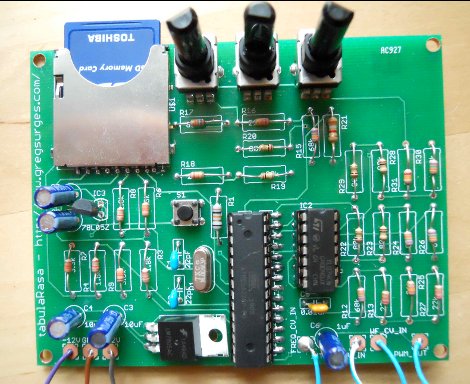
The tabulaRasa is a digital wave table oscillator, and features control of frequency, wave table selection, and interpolation. The device is split up into 2 parts. One is a pcb with a healthy amount of resistors, 3 potentiometers, ST TL074 JFET op amp, atmega328 and a SD socket.
The second part is software for your computer that allows you to edit or create your own waveforms. There are 3 different modes of control. Breakpoints, which allows you to set the waveform points and allows up to sixteen. Harmonic allows amplitude control over 16 harmonically-related sine waves, finally, the third mode lets you load in short sound clips.
Once you’re happy, save to a SD card and pop it into the board, and you’re ready to make some noise. The project page states at the end “tabulaRasa is in the last stages of development, and will be available soon.” so you cant get your hands on one just yet, but if you’re interested [Greg] has a kickstarter page setup where you can find out details on pricing.















The project seems to be a powerful tool.
I think that it would have been better if the waveforms were stored in RAM and the device would connect directly to the computer.
Even sound clips could be played back directly on a fast (close to 0.5Mbps) serial.
Ummm… What’s with all the through-hole components? Is it the 90’s again?
24 resistors are not allot of resistors …. the creator just desided to make them overly largely spaced for 1/8 watts
@Ekaj it works the same it takes half the time and its easier to debug and fix if you make a mistake
just because we CAN do SMD does not always mean its best
Project is kind of neat, but there’s very little real design and build detail. This doesn’t *yet* deserve a Hack a Day post.
@biozz:
Even though I find Ekaj comment completely useless pedantic and stupid, I still find that making SMD is simpler and faster. I find SMD parts easier to solder and you don’t waste time making the holes (which is not a so easy part). The only drawback I can think of is that the parts are harder to find.
@Faelenor
well holes are made by the PCB etcher in his case and like i said its far easier to debug your prototype when allt he pins are nice and spaced out
and i have done miniature production line SMD and threw hole boards and the threw hole boards are the easiest and quickest if you dont have a reflow oven as you just stick all the components in and flip it over and solder it all at once in all the same basic movement
with SMD you have to take the time to align everything than check everything than deal with many more problems
dont get me wrong i love SMD soldering its fun and it produces a nice and small final result but its not always best expecally for a prototype
I like through hole. I fear the day they become unavailable.
I like the sound, and the idea. It would be awexome if it had a serial connection to the computer to give you the ability to load new samples without ejecting the SD card.
Those resistor foot-prints aren’t large enough…